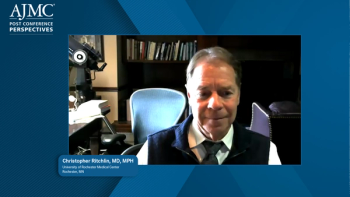
The Utilization of Combination Therapy in Patients with Diabetes
Key opinion leaders discuss the role of combination therapies in the management of diabetes.
Episodes in this series

Yehuda Handelsman, MD, FACP, FNLA, FASPC, MACE: Jennifer was talking about combination therapy for blood pressure, with 2 to 3 drugs. Early on, this would probably work much better. I think you go with an ACE [inhibitor] or an ARB [angiotensin receptor blocker]. I tend to go with ARB because we have more angioedema…when we go with ACE [inhibitors], even though ACE is a great drug. The goal we put into the guidelines over 8 years ago is if you’re 20 over 10 from your goal, you go with 2 medications from the get-go. Based on that concept, we looked at lipids. If you’re 50% away from the goal, you go on a combination therapy on an LDL [low-density lipoprotein] reduction. It’s the same concept. When do you start this? How is your AI [artificial intelligence] working? It takes information and calculates to say, “The patient needs more medication from the start.” It’s the same thing with hyperglycemia.
At the same time, there was an algorithm pathway to treatment published in 2009 on how to treat. It looked at metformin, sulfonylurea, and insulin with ACE. First, you can go with 1 drug, but it depends on how far you are from the goal. At [a glycated hemoglobin of] 7.5%, you can go with 1 drug. But if you’re above 7.5%, then you need to go with 2 drugs. At that time, we didn’t even have the tools with 1 drug so that 7.5% could get us to the goal. Now we do have those tools, but insulin from 7.5% will not get you to your goal. If you get below 7%, you get hypoglycemia with just insulin. It’s not an answer. The point is that a combination therapy for hyperglycemia, blood pressure, and lipids from the get-go based on the patient’s characteristics can already be done. They may need some help, but we can do it early on.
Jennifer B. Green, MD: The other nice thing about using combinations early is that you don’t have to use the maximum doses of both drugs. You get this complementary physiological or metabolic benefit from being on 2 classes. But because you don’t have to give the highest dose of the 2 drugs, you can minimize the potential for adverse effects or intolerance to the medications that are used.
Yehuda Handelsman, MD, FACP, FNLA, FASPC, MACE: There was a study called Steno, which showed that the comprehensive approach works. It didn’t show that it worked immediately—after 8 years—but it showed it after 15 years. What’s interesting about Steno is that they looked at very loose goals. A1C [glycated hemoglobin] was 7%, LDL was 100 mg/dL, and blood pressure was 130 mmHg, if I recall correctly. At the end of the day, only 28% of people got to the glucose goal. Only 40% of people got to their blood pressure goal. About 50% to 60% of people got to the LDL goal. But getting all 3 together got this remarkable result [in the Steno study]. That’s what the heart failure people are doing. They take what they call the 4 pillars—a 4-drug approach—and do exactly what you said, Jennifer. [They] start with low doses, get them on it, and go up to max dose as much as possible. Is that an approach you think you could do?
Eugene E. Wright Jr, MD: I think we could. Some of the opportunities we have to use that approach is to recognize that all these systems are connected. Identifying them early and targeting them early is not dissimilar to what we do with diseases like cancer. We think about all the different targets we have to treat. We treat them early, and we treat them aggressively, intending to induce remission. If we took that approach with diabetes and in the cardiorenal system, we’d see different outcomes.
Yehuda Handelsman, MD, FACP, FNLA, FASPC, MACE: Remission—is that something you in the insurance world would like to see the patient get to?
Jaime Murillo, MD: Who wouldn’t? It made me think about a group that is called Level2, which you may have heard of. It’s a group that’s completely value based, with about 50,000 patients with diabetes across 25 states. Their goal is to achieve remission for most. Obviously, everybody has different stages of diabetes, but that’s a combination of utilizing the right formulary CGMs [continuous glucose monitors], Fitbits, coaching, lifestyle intervention, behavior change, and so on. It’s interesting that you’re talking about it, because I suspect that 10 years ago people weren’t talking about remission, and now there’s hope that we can achieve it. I’m curious to hear more about it.
Yehuda Handelsman, MD, FACP, FNLA, FASPC, MACE: In a minute I’ll let you talk about what remission means, at least officially. Things change with the tools we get. I’ll use lipids as an example. Getting to an LDL below 70 mg/dL used to be very tough. A few patients got there in combination therapy, but the majority could not get to below 70 mg/dL—let’s say with ezetimibe and high-dose statins, for example. Some patients need it, but not the majority. All of a sudden we have a tool, PCSK9. In the majority of patients, we can get LDL down as much as we want. There’s a new way to approach this. We used to call them residual-risk patients—high triglycerides, low HDL [high-density lipoprotein]—but now it’s also patients who have the LDL go down. Similar things happen with diabetes.
Transcript edited for clarity.
Newsletter
Stay ahead of policy, cost, and value—subscribe to AJMC for expert insights at the intersection of clinical care and health economics.









































